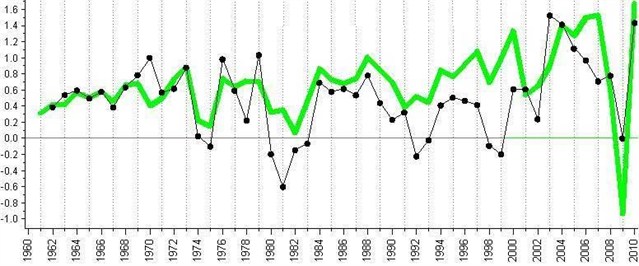Global Warming: New Research Blames Economic Growth
 It’s a message no one wants to hear: To slow down global warming, we’ll either have to put the brakes on economic growth or transform the way the world’s economies work. That’s the implication of an innovative University of Michigan study examining the most likely causes of global warming
It’s a message no one wants to hear: To slow down global warming, we’ll either have to put the brakes on economic growth or transform the way the world’s economies work. That’s the implication of an innovative University of Michigan study examining the most likely causes of global warmingThe study, conducted by José Tapia Granados and Edward Ionides of U-M and Óscar Carpintero of the University of Valladolid in Spain, was published online in the peer-reviewed journal Environmental Science and Policy. It is the first analysis to use measurable levels of atmospheric carbon dioxide to assess fluctuations in the gas, rather than estimates of CO2 emissions, which are less accurate.
For the study, the researchers assessed the impact of four factors on short-run, year-to-year changes in atmospheric concentrations of CO2, widely considered the most important greenhouse gas.
Those factors included two natural phenomena believed to affect CO2 levels – volcanic eruptions and the El Niño Southern oscillation – and also world population and the world economy, as measured by worldwide gross domestic product.
Tapia Granados and colleagues found no observable relation between short-term growth of world population and CO2 concentrations, and they show that incidents of volcanic activity coincide with global recessions, which may confound any slight volcanic effects on CO2.

Annual growth of the world economic output (green line, trillions of 2000 US dollars) and annual change of estimated CO2 emissions (millions of Kt, black dots). Data on CO2 emisions for 2009 and 2010 were computed from preliminary estimates of carbon emissions obtained from the Carbon Dioxide Information Analysis Center (CDIAC) of the US Department of Energy on March 2012. All other data from the World Bank (that takes estimates of CO2 emissions from the CDIC). (Credit: Image courtesy of University of Michigan)
——————————————————————————–
With El Niño outside of human control, economic activity is the sole modifiable factor. In years of above-trend world GDP, from 1958 to 2010, the researchers found greater increases in CO2 concentrations. For every $10 trillion in U.S. dollars that the world GDP deviates from trend, CO2 levels deviate from trend about half a part per million, they found. Preindustrial concentrations are estimated to be 200-300 parts per million.
To break the economic habits contributing to a rise in atmospheric CO2 levels and global warming, Tapia Granados says that societies around the world would need to make enormous changes.
“Since the mid 1970s, scientists like James Hansen have been warning us about the effects global warming will have on the Earth,” Tapia Granados said. “One solution that has promise is a carbon tax levied on any activity producing CO2 in order to create incentives to reduce emissions. The money would be returned to individuals so the tax would not burden the population at large.
“What our study makes clear is that climate change will soon have a serious impact on the world, and the time is growing short to take corrective action.”
You can return to the main Market News page, or press the Back button on your browser.

